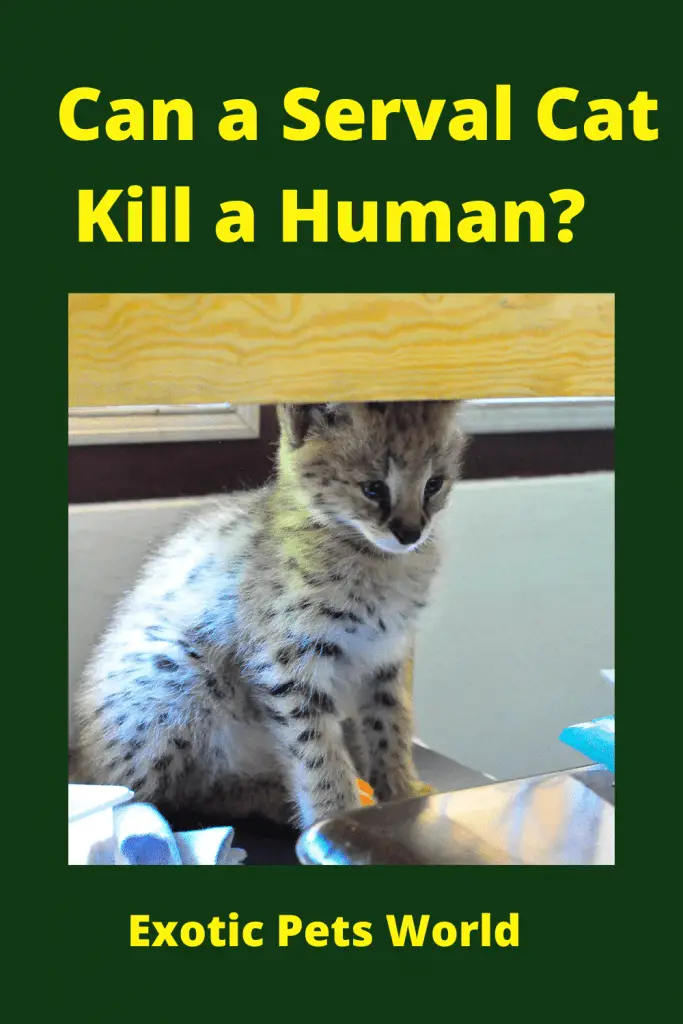Can a Serval Cat Kill a Human?
Can a serval cat kill a human? The Serval is a wild cat of small to medium size that is endemic to different areas of Africa. They’re around 21-24 inches on their shoulders and 20-40 pounds in weight. Compared to their body size, these wild cats have very long legs (the longest of any cat). Their usual lifespan is 19 years or so.
They expend their time roaming their home ground, which may vary from 4-12 square miles, typically overlapping with other servals. To discourage encounters with other servals who may cross their territory, these isolated cats use scent contact. They Mark Their Territory in this manner.
Servals ( leptailurus serval ) will leap more than six feet in the air to land on their victims until a meal is located, providing a lethal bite to the head or neck. Servals are uncommon in northern Africa but widespread in southern Africa, where they are found at altitudes up to 12,500 feet in grasslands, moorlands, and bamboo thickets. They like living around water.

The serval cat is a cute animal owned as an exotic pet by specific individuals. While you might obtain from a breeder a serval cat, they are deemed feral cats.
You need to build a big, stable outdoor enclosure and have a warm atmosphere year-round to own a serval cat. They may need to feed on entire prey food products which require an experienced exotic veterinarian to offer veterinary treatment.
Understanding the risks involved in owning a wild animal is essential. Serval pet possession is unlawful in certain areas, and others include certificates, approvals, and inspections. To determine what may occur, you have to consult with local regulations. Serval cats are often hard to re-home if the animal can no longer be cared for.
Have Servals Killed People?
With an approximately 50 percent kill record, servals have deemed the strongest hunters in the cat community. Servals kept as Pets, owners can be attacked by pets can destroy humans, or trigger serious injuries needing hospitalization.
For reference, a 4-year-old boy received plastic surgery in New York in June 2000 for a bite to the throat and two puncture wounds to the face after being assaulted by a 40-pound African serval being taken for a stroll. The guy walking the cat was given some stitches to his hand for bite wounds.
After being assaulted and bitten on the throat by a 40-pound declawed African serval at a picnic, a 7-year-old boy in Florida was admitted to hospital in December 2001. The boy was walking when the unattended Serval leaped on him and pushed him to the ground. In the United States, regional media have recorded many cases of servals fleeing from their owners.
Species History of Serval Cats
The serval cat is from Africa where this tall cat can be camouflaged by tall grass and bushes that allow it to sneak up on its prey. It is recognized that they mimic cheetahs, but they have shorter tails than their more significant relatives. Usually, they search where they can hide and remain close to the stream. They are solitary in the wild and occupy four to 12 square miles of the homeland. Serval cats from Africa are not on the registry of threatened animals.

Servals are short jumpers and seasoned diggers with any cat’s longest legs (compared to their bodies). To get under a barrier, they will grab birds about nine feet in the air and dig a few feet into the dirt. Servals make several noises or vocalizations: a high-pitched scream to call other servals, growl, a spitting noise, purr, and more.
Since the ancient Egyptians, the Serval cats have been owned by humans and are depicted in their paintings. They are not domesticated, though. Around a century ago, breeding stock arrived in the United States, and you may see serval cats that have been excluded from African imports for several decades. These domestically bred servals are often subject to limits on the possession of wild cats and exotic animals.
Serval cats have also been mixed with domestic cats by breeders to create offspring, such as the Savannah cat.
Considering a Serval Cat? Know the Risks of Having One.
Usually found south of the Sahara Plain, a serval is a cat native to the African grasslands. The cat has a slim body with long legs. With black or dark brown marks, the jackets are mostly shades of tan or orange. The coat design encourages the cats to camouflage themselves in tall grass while hunting.
As exotic pets today, several individuals hold serval cats, but they are small in size. Many servals can be encountered, and there is a valid explanation for this at zoos or big cat rescues. Serval is not a house cat with outstanding skills.
Instead, a serval cat is a feral animal with special requirements and hereditary instincts that must be nurtured in a given situation. Serval is a wild animal, which is why many states either forbidden possession of it or have required special licenses to contain one.
There are some dangers involved with having a serval cat as a home. Before agreeing to carry a serval cat as a domesticated pet into your household, please take seriously any of the following:
Risks of Having a Serval Cat
Serval is a feral animal, which is why many states either forbidden possession of it or have required special licenses to contain one. There are some dangers involved with having a serval cat as a home. Before agreeing to carry a serval cat as a domesticated pet into your household, please take seriously any of the following:
- To discover, swim, search, run and sometimes ascend, Serval cats require zoo-like environments. Such environments may be costly to build and sustain an environment so limited. An interior-only alternative would not encourage a serval cat to expel any of its energy or meet its instincts.
- Special diets are required for Serval cats. This is not a pet that you should feed Meow Mix and presume that it suits their food requirements.
- Serval cats are not traditional lap cats of your sort. Sure, they may be affectionate and not necessarily hostile to people, but it’s always a wild animal to note. They have intrinsic, inherited impulses that they must satisfy.
- Serval cats are deemed feral animals, and in many U.S. states and other nations, the law limits their possession. You will find it hard to control such an animal if you try to get a serval cat and then decide it would not fit. This is since the requisite permits would still need to be held by associations or persons obtaining the animal.
- Serval cats prefer to go night hunting. Bear in mind that, on average, a serval cat weighs 29 pounds. Imagine playing or hunting your Serval at night, and those 29 pounds fall on you in the mid-sleep room.
- Servals love naming their territories. This means peeing on yourself and household objects. Like other domesticated animals, servals will not often take to litter boxes, and they may need a somewhat larger than the average litter box.
- Serval cats for homes with small children are not recommended. They play with their teeth and nails, and with children, they can be too rough or see them as games or prey. It’s not probable, but it’s likely.
- Cats from Serval play rough. On their many excursions, they can knock over large objects, scratch and tear furnishings, hop incredibly high, and crash into things. With good reflexes, cats are quick, and they also use their teeth and claws during play.
- Plus, for Serval cats, scratches are even more significant. Their power is far greater than that of a regular cat, and they can trigger it by merely playing even though they do not intend harm.
- Servals have a bite force of 172 Newtons on canine teeth, whereas wild domestic cats have a bite force of 56 Newtons on canine teeth. Servals can subdue greater prey than feral cats can because of this more vigorous bite intensity.
- Serval cats, including leopards and other cats in the wild, do not pursue their food. They listen and wait until they’re ready, and then they hop in the air and land on their prey. They usually administer a lethal bite to the neck until they hold them or hinder them with their weight. With an approximately 50 percent kill record, servals have deemed the strongest hunters in the cat community. (The kill figure of a domestic cat is something like 10 percent)
- The support cat’s total life expectancy is around 22 years. This is longer than the domestic cat, so you should understand the responsibility of taking care of a wild animal for a long time before deciding to get one.

Social Organization of Serval Cats
Male and female servals establish and lead lonely lives in different domains. External touch is limited to mating. Servals are often seen in groups, or a female maybe with her kittens at a party. Female servals vary from ( 1 – 5 Miles ) 2-9 km in exclusive territories.
Male-held territories usually are double the size of females, and two or three female regions will overlap. Servals have been identified to have home ranges of ( 7 Miles ) 11.6 km2 (males) and 9.5 km2 (males) in Ngorongoro Crater, Tanzania (females). These home ranges were often found to overlap to the degree that the user used only 21 percent of the range exclusively. Up to four servals have been found at times to be within 200 m of each other.
The home area was roughly 6.2 km2 (range 3-9 km2) for a female serval who was hand-raised and then released into a Natal nature reserve. Boundaries with regular scent marks and scratch marks are well established. To label their domains, Servals continually spray with urine.
This is a rather powerful alarm for a serval to maintain its distance from an overlapping territory. By sitting and facing each other, male servals show ritualistic hostility and one animal positions its front hand on the other’s chest. Then the second Serval bobs his head, and the uplifted paw can bite. This exchange may intensify into a fight, but a protracted ‘stare-off’ most frequently remains.
Diet and Nutrition for Serval Cats
Servals ingest whatever is present in the wild, finding it impossible to reproduce their perfect natural diet. You may not have access to all the wild servals that Africa has to sell, but rats, rabbits, birds, fish, butterflies, snakes, and frogs are typically on the menu with different protein sources.
If your Serval consumes so quickly that it regurgitates all straight back up due to clogging its stomach, whole prey should be given but do not be frightened. If the stomach acid has not begun fermenting, it will attempt to re-eat the regurgitated food.
Servals Play with Their Prey
To hunt their quarry, servals use their sight and listening rather than their sense of smell. Until consuming it, they sometimes play with their meal. The Servals are brilliant cats. A game or puzzle that helps the cat problem-solve while feeding them enables the meal to be more satisfying and counts throughout their everyday routine as an entertainment exercise.

Are Serval Cats Dangerous?
Some feral cats are not any larger than a medium-sized puppy, but their wild tendencies are always there, and they are cunning escape artists who are certainly not ideal house pets. In a home or enclosure environment, they are difficult to control and pose a danger to humans, children, and other pets.
Are Savannah Cats Dangerous?
No, cats from Savannah aren’t harmful. Although the breed traces its history to a wild cat breed and, when bored, has a propensity toward aggressive behavior, a Savannah cat may not hurt humans.
Many of the questions over the Savannah Cat’s ownership derives from its roots. The breed is a hybrid between the wildcat Serval and the domestic cat. On the African plains, the Serval lives and is recognized for its graceful, long, and lean characteristics and distinctive spotted hair.

Serval Cat Care
For these intensely energetic and lonely cats who wander at least four miles a day in the wild, wide outdoor enclosures are necessary. They are most aggressive at night, becoming nocturnal, and are known to hop out of fenced areas or dig out under fences.
On both sides with a top, an outdoor ring has to be fully fenced in, and the sides can reach down a few feet deep into the grass, a plain dog run would not be enough. Often necessary for drinking, bathing, and maybe even encouraging your serval cat to catch its fish is a pool of water.
Serval cats, especially if they are bottle-raised and hand-fed, will bond with humans. Usually, for life, they’re a one-human pet and bond. You’re going to have to spend some time with the cat, playing at his pace, eye-to-eye.
In school, they may be affectionate but need patience and a gentle hand. While you can attempt to socialize a serval, they always stay wary of outsiders, and visitors can be scared.
Typically, these cats are shy throughout the day and more aggressive at night. Servals can be active in play, and it should be in a serval-proofed cat space that doesn’t have breakable objects, cables, or other dangers if you carry a serval into the home.
Although servals may be litter-trained, be mindful that it is part of their usual way of marking their territories to urinate objects. You will need a unique serval leash for protection while walking your Serval because they are not designed like domestic cats.
If you take a trip, require a rest, or develop your health conditions, you would need to have a plan in motion for others to care for your serval pet.
Life span of Serval Cats
Serval cats have an estimated lifetime of 12 to 20 years. Servals are non-seasonal breeders, but where the large prey density correlates with new plant growth, births appear to peak during the wet season (Smithers 1978).
In a den or nest, surrounded by thick foliage, or in an empty burrow, the female Serval guards her kittens; however, she will often transfer them after birth to new hiding places to shield them. Females can often use tree hollows to cover kittens. Female slaves, like the cheetah, rear their kittens on their own and must abandon them when hunting.

Reproduction of Serval Cats
Servals, even for breeding, are solitary creatures. They are polygynous because, for maximum reproduction, males’ territories converge with as many females as possible. While there is no fixed breeding interval, in the season, mating happens more frequently. For many days, just before entering the Estrus, a female almost ready to breed will hunt and court the male. It can last as little as one day for Estrus.
Female serval cats give birth to 2 to 3 kittens during a 10 to 11 weeks gestation period. Around ( 1/2 Lb ) 250 g at birth, these young boys double in size in the first 11 days of birth. After five months, they are weaned, and their permanent canines mature at six months of age.
Young serval cats remain with their mother for up to a year before they are thrown out to pursue their territories. To create a new territory, males require 1 to 2 years. About the time kittens are autonomous, between 18 and 24 months, sexual development takes place.
After mating, female cats are likely to search for good dens in which to grow their young. Shelters range from thick shrubs to openings or abandoned burrows beneath rocks. A mother’s conduct shifts to satisfy her youth when she needs to forage herself and them. Hunting relentlessly, she needs to stop her kittens from joining her. She’ll relax in the late afternoon before searching for the next meal. Males offer no maternal care for the kittens.
Health Problems Serval Cats
Ensure that a doctor who can care for exotic pets has access. Servals, including domestic cats, need the same annual immunizations and deworming.
Although several pet facilities are declared to deter public injuries, this is a procedure that may contribute to an infection. In a fight with other species, it often leaves the servo weak. For servals, one typical veterinary emergency is swallowing foreign objects that could be stuck in their throats or challenging to move through.

Final Thoughts
With exotic pictures of leopards and other great cats, there is no question that hybrid animal types are stirring our imaginations. The adoption of a hybrid pet, though, should entail the same sort of careful and reasoned thinking that should be required with adopting or buying a genuinely domestic animal like serval cats. Look at the particular circumstance and lifestyle, and the pros and cons of your life’s remainder are interacting with a specific animal.
Due to the shortage of foster homes, please remember the millions of cats euthanized annually in shelters.
So instead of getting into your home reminders of the forest or the savannah by purchasing a hybrid pet, think of the tiger or leopard or lion that is in every domesticated cat’s heart. In more respects than one, small cats are like large cats.

